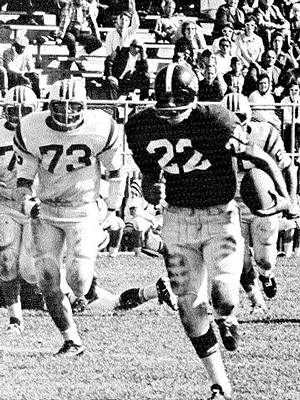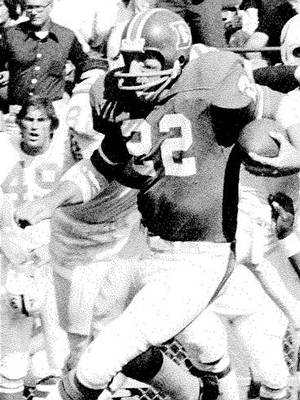

"DENVER BRONCOS"
HELMET NEWS, HELMET REFLECTIONS FOR JUNE
2008
WHEN THE WHOLE IS GREATER THAN THE SUM OF ITS PARTS
By Dr. Ken
One can certainly cast pity upon those fans who supported the Denver Broncos in their formative years. With their rather ugly washed out brown, mustard-yellow, and white uniforms with vertically striped socks, the early Broncos were a hapless bunch. Between the team’s 1960 debut through 1973 they no doubt set an unofficial pro football record of having rostered fifty-seven quarterbacks and of those only four completed more than fifty percent of their passes. It wasn’t until 1973 that the team would finally post a winning record. During this bleak period of existence, the Broncos could point to a few talented players and an infrequent star whose presence would excite the fans, but consistently high level play was absent. When a team is a downtrodden underdog, it’s easy to cheer them on and I did. I liked the American Football League from its inception. I was attracted to the role of the underdog, the retread former NFL stars, and the many unknowns who played exciting, wide open football. In our racially mixed neighborhood, many of the African Americans, especially the adults, made mention of the fact that the AFL seemed to be giving the Black man more of an opportunity than the longer established NFL. I cheered for the local New York Titans, a mediocre team at best, especially on those occasions when we could find the money to take the subway to the Bronx and watch the team in person while avoiding the huge sewer rats that crawled through the upper decks during the course of games, oblivious to the sparse turnout of fans. I utilized fullback Charley Tolar of the Houston Oilers as a source of inspiration because of his sawed-off stature (see Helmet News/Reflections May 2008) and I found myself hoping that those pitiful Broncos would win a few games.
As per usual, my main focus was upon the running backs. While the Denver quarterback situation was always a mess, they seemed to have at least one solid back each season. Some of the early stars included Gene Mingo, Villanova’s Billy Joe, and Hewritt Dixon. When Joe was traded to Buffalo in exchange for Carlton “Cookie” Gilchrist, many believed this would make a major difference in their offensive production but after a year, Cookie was gone and in a Dolphins' uniform. When he returned for one game a season later it was obvious that he wasn't the answer to their problems. Abner Haynes had put his best days behind him when he arrived in Denver and Wendell Hayes gained more acclaim when he was a vital cog in the Chiefs offense that went to the Super Bowl after the 1969 season. It wasn’t until 1967 that hope appeared in the form of a terrific draft and Syracuse running back Floyd Little. Head Coach Lou Saban hit paydirt with picks one through four, the first of whom was Little. However, history showed that Pete Duranko and George Goeddeke of Notre Dame, and offensive tackle Mike Current of Ohio State were solid choices. Current spent but part of the year in Denver, going to Miami, but he returned to the Broncos the following season and became a mainstay in the offensive line. One of the unsung and for most fans, unknown rookies in the ’67 draft was Francis Xavier Lynch of what was then tiny Hofstra University in Hempstead, New York on Long Island. As a fifth round draft pick, most Denver fans were no doubt scratching their heads over the choice but Lynch proved to be one of the “unknowns” who played an important role in Denver’s ascension towards respectability.
Home for one of the school vacations, I was typical of most college football players who worked a physically demanding job as an ironworker and welder whenever there was a break from classes. Unlike today’s “student-athletes” whose participation in college football is a full time undertaking requiring their presence on campus twelve months per year with mandatory and supervised training sessions, players of our era in the mid-1960’s were set lose with vague instructions to “run and stay in shape”. Most of us worked construction or similar type jobs and ran in the pre-dawn or evening hours. The few who lifted weights did so in crude, under equipped garages or basements or in the infrequently seen storefront gyms in some of the larger cities. During one of my stays at home, local Long Island great Wandy Williams introduced me to Lynch. Williams had graduated from Malverne High School as one of the most sought after running backs in the nation. He broke Gale Sayers’ frosh rushing records at Kansas before returning home due to family related matters. He played successfully at Hofstra, at the time a small program whose squad consisted primarily of local boys who commuted to class and the school usually did not get the caliber of player like Williams. While Wandy had another two seasons of eligibility, Lynch had just completed a stellar career at the Long Island college and had established a local reputation. Wandy invited me to train in what passed for the “Hofstra weight room”, a new Universal machine that was set up in an otherwise nearly empty room in the basement of the field house.
It was here
that I was introduced to Fran Lynch who was a solid looking 6’1”, 200 pounder.
Wandy stated that Fran was the “smartest player on the team” and the most
versatile. Some of the fellows I knew who played in various colleges knew of
Lynch and had talked about him the previous summer but it was quite a shock and
a time for quite a bit of local rejoicing when he was chosen in the draft. Lynch
had graduated from Roger Ludowe High School in Fairfield, Connecticut and
admittedly was far from the best player on his team. He attended Oklahoma
Military Academy, now renamed Rogers State University, and transferred to
Hofstra where he set a number of rushing records. Unfortunately, when the
schedule is filled with opponents like Gettysburg Otterbein, Bridgeport,
Muskingum, and C.W. Post, few outside the local area recognized that the school
actually played a very good brand of football under highly respected head coach
Howdy Meyers. With his highest honors being All Middle Atlantic Conference,
perhaps everyone underestimated Lynch’s chances and talent but he was a
hard-nosed and very motivated player. The first impression I received of him was
the most lasting. He was the only one in the room, sitting by the Universal
machine, recovering from a set of exercise. Head down, completely focused on his
upcoming exercise, drenched in sweat, he was the picture of complete
concentration. As the workout progressed and Wandy and I joined in, he also
proved to be considerably stronger than his lean appearance might have
suggested.
 |
It may have seemed like a Denver based Long Island party when Lynch joined quarterback Jim LeClair and wide receiver Tom Cassesse who had set many records at C.W. Post College as they too were brought into camp as free agents for the ’67 season. LeClair, who had sharpened his skills with Montreal of the Continental League and the Waterbury Orbits, the N.Y. Jets' farm team, in the Atlantic Coast League, received playing time in 1967 and ’68 before returning to the minor leagues and finishing the 1968 season with the ACFL Westchester Bulls. Cassesse was cut later in ’67 and finished that season with the Bulls before becoming an assistant coach at Post and then in subsequent years, compiling the most wins as a head high school coach in Suffolk County (LI) history. Lynch not only made the squad but became a special teams standout, earning a reputation as a dependable, tough player.
 |
“Fran looks frail” a teammate said, “but he is probably one of the strongest men
on the Broncos. He is a hard worker and a team man above all.” When Lyle Alzado
was in town and we got together for a lifting or running session, he echoed the
statement made about Lynch years before by Wandy Williams when he said, “Fran is
probably the smartest player on the Broncos, he never makes a mistake and that's
one of the reasons he always plays.” Never a star, Lynch would be Floyd Little’s
primary substitute and filled the same role for Otis Armstrong when he stepped
into a starting position for Denver. Fran could run, catch, and block which
often placed him on the field, leading the way for the more acclaimed running
backs. He played from 1967 through 1975 and rushed for a total of 1258 yards
while scoring fourteen touchdowns. He returned kicks and punts when needed and
utilized a combination of toughness, intelligence, and reliability to put
together a quiet but productive nine year career as a professional football
player. Dedicated to his teammates and the success of the team, Fran Lynch is
the type of player I would think about when I saw the Broncos helmet from that
time period. Noting the changes that the Broncos helmet went through from its
inception as a brown shell with a white center stripe and displaying white
numerals on the side, through the orange headgear with the white center stripe
and unique white bronco logo, to the more familiar blue helmet with the “D” and
snorting horse,
(see http://www.helmethut.com/broncindex.html
for Broncos helmets) Fran Lynch typified the majority of players in the AFL and
NFL much more than did the more publicized and hyped up super stars of that era
or today. The unsung majority who do the grunt work and don’t seek out attention
yet earn the respect of teammates and opponents because of their dedication to
doing their jobs to the best of their ability is what Fran Lynch represented,
traits that would allow him to play today.